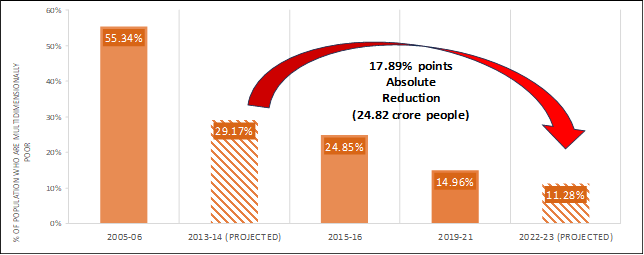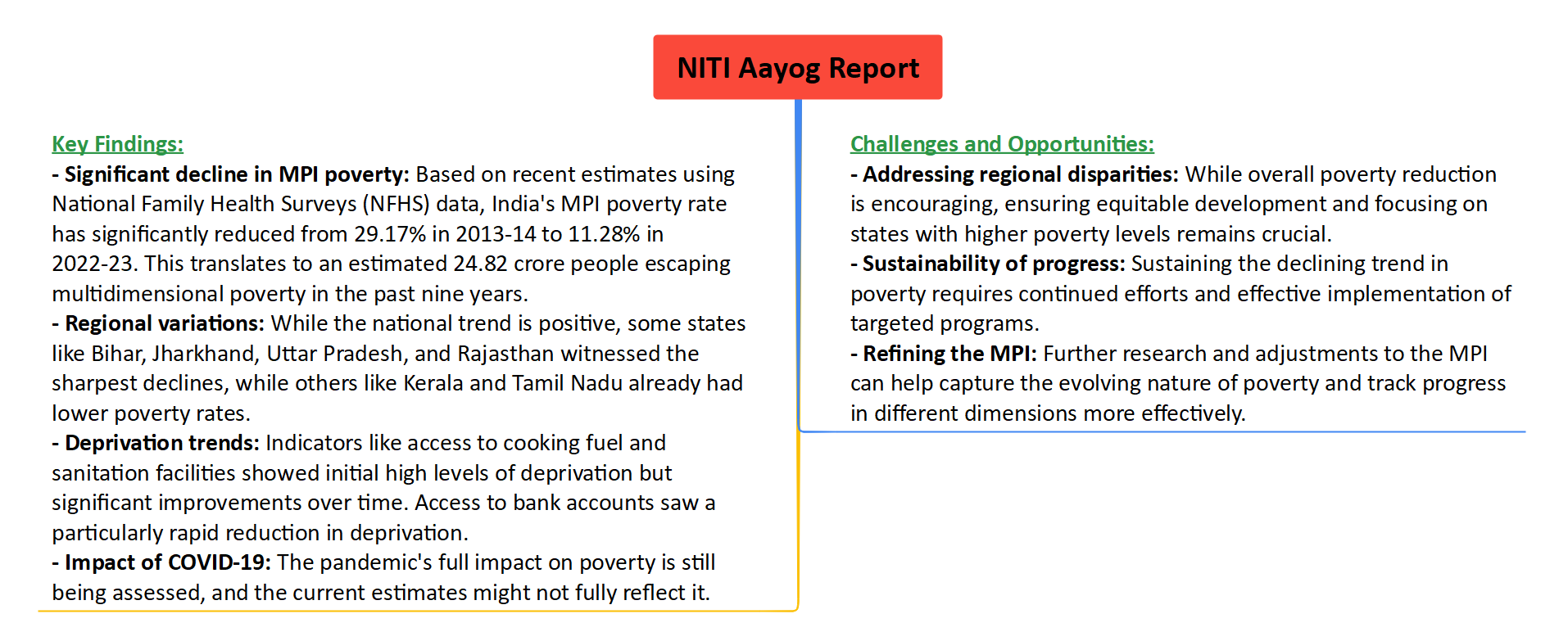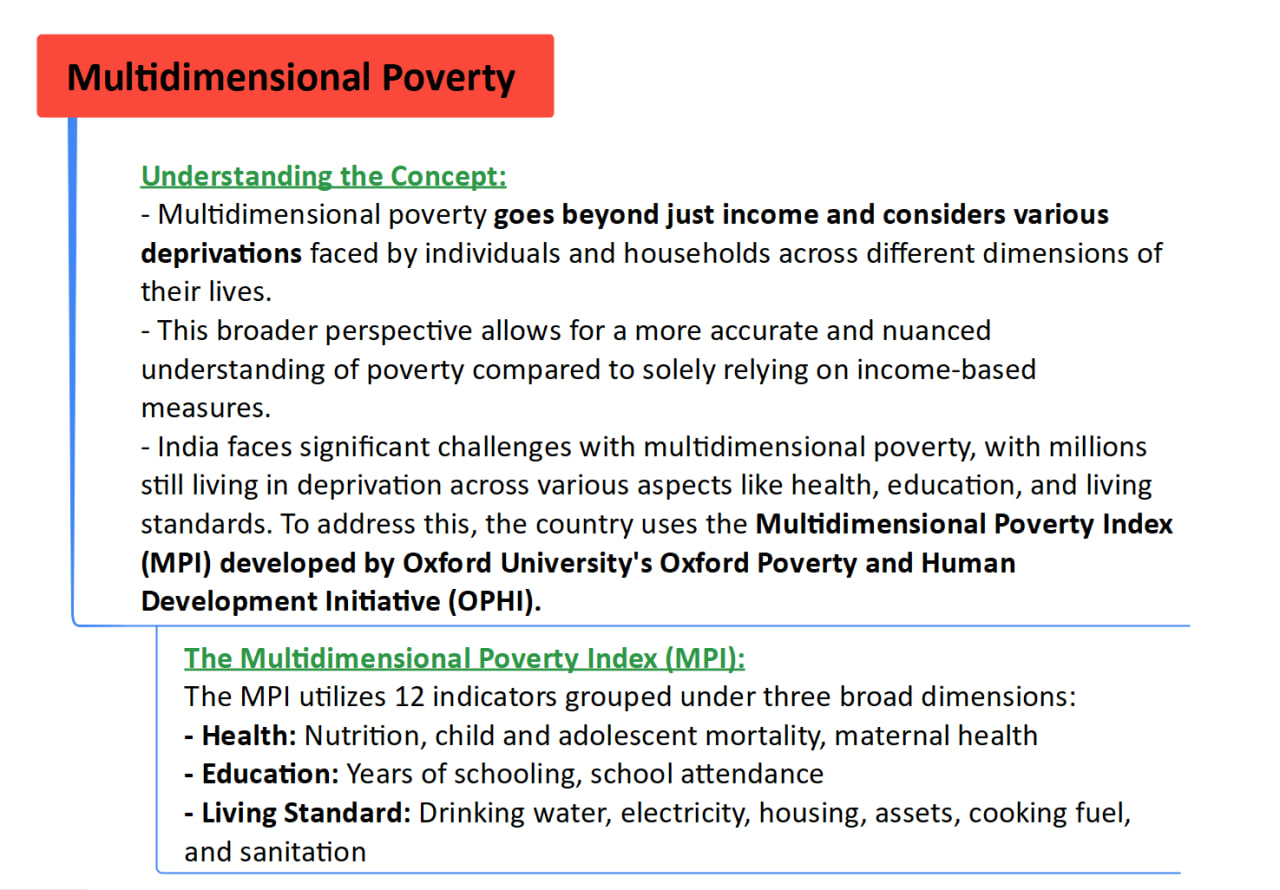Description

Copyright infringement not intended
Picture Courtesy: pib.gov.in
Context: India's multidimensional poverty rate has significantly decreased from 29.17% in 2013-14 to 11.28% in 2022-23, indicating a substantial improvement in living standards across numerous dimensions.
Details
- The discussion paper released by NITI Aayog provides insights into the changes in India's multidimensional poverty rate over the years.

Multidimensional Poverty Index (MPI)
- The MPI considers twelve different indicators categorized under three dimensions: health, education, and standard of living.
- This index offers a more holistic measurement of poverty beyond just income levels.
Overall Reduction in Multidimensional Poverty
- The share of India's population living in multidimensional poverty has decreased significantly, from 29.17% in 2013-14 to 11.28% in 2022-23.
- In absolute numbers, NITI Aayog estimates that approximately 24.82 crore people escaped multidimensional poverty in the last nine years.
Regional Variances
- States like Uttar Pradesh, Bihar, Madhya Pradesh, and Rajasthan recorded substantial declines in the number of people classified as poor based on MPI.
- Bihar, for example, experienced a 53% drop in the share of MPI poor from 56.3% in 2013-14 to 26.59% in 2022-23.
Severity of Deprivation
- The severity of deprivation, measuring the average deprivations faced by the multidimensionally poor, declined at a slightly lower rate between 2015-16 and 2019-21 compared to the earlier period of 2005-06 to 2013-14.

Long-Term Trends
- The discussion paper utilizes data from National Family Health Surveys (NFHS) conducted in 2005-06, 2015-16, and 2019-21 to understand long-term poverty trends.
- Reduction in the share of MPI poor in India's total population accelerated after 2015-16 compared to the decade before.
Impact of COVID-19
- The paper notes that the estimates for 2022-23 may not fully reflect the impact of the COVID-19 pandemic on the economy. NHFS-5 data collected between 2019-21 was collected before the pandemic.
Progress Towards Sustainable Development Goals (SDGs)
- The discussion paper suggests that India is likely to achieve Sustainable Development Goals (SDG) Target 1.2, which aims to reduce the proportion of people living in poverty by at least half according to national definitions.
Dimensional Changes
- Indicators related to the standard of living dimension showed the highest levels of deprivation in 2005-06. However, significant improvements have been observed in access to cooking fuel, sanitation facilities, and bank accounts over the years.

Conclusion
- India's progress in reducing multidimensional poverty is commendable, but the fight is far from over. Continued efforts are needed to address remaining disparities, refine measurement tools, and integrate multidimensional poverty reduction into broader development strategies. By adopting a holistic approach, India can ensure that all its citizens have the opportunity to escape poverty and lead dignified lives.
Must Read Articles:
Multidimensional Poverty Index (MPI): https://www.iasgyan.in/daily-current-affairs/multidimensional-poverty-index-mpi
Health National Family Health Survey-5: https://www.iasgyan.in/daily-current-affairs/health-national-family-health-survey-5
Extreme Poverty In India: https://www.iasgyan.in/daily-current-affairs/extreme-poverty-in-india
|
PRACTICE QUESTION
Q. How do the various dimensions of poverty, such as income inequality, access to education, healthcare, and basic amenities, interact and contribute to the multidimensional poverty in India, and what strategies can be implemented to address and alleviate these complex challenges?
|
















